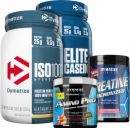
9 Most Underrated Leg-Training Tips
If you're looking to make serious gains down under, don't overlook these critical but oft-overlooked tips!
If I had to come up with the most underrated tip for leg day, it would easily be, "Don't skip leg day!"
Many beginners might think, "Why do leg training when there's nobody on the bench press?" But even if you've reached that stage at which leg training is no longer considered an optional workout, you probably still have questions relating to your lower-body workout.
I've identified the nine tips I consider to be the most underrated.
You can't just show up on leg day and expect a great workout
Most bodybuilders know that training legs is the single hardest workout of the week, namely because of the amount of mass engaged and the requisite volume to train all those large muscle groups. Hardcore trainers are all too familiar with the refrain about praying to the porcelain god after a particularly tough leg day.
Casual lifters, on the other hand, often see leg day just like arm day without the benefits of looking good in a tank top, so they're quick to miss a leg workout or three.
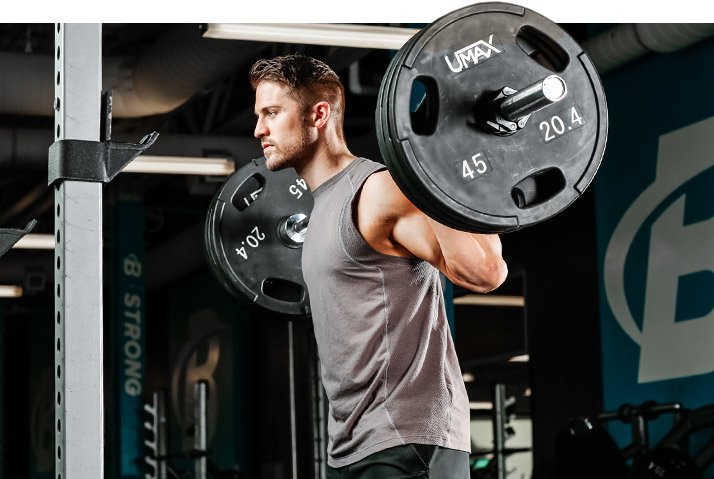
"Leg day is a whole different animal compared to your other body-part workouts," says Mike Hildebrandt, director of fitness at Axiom (Boise, Idaho), three-time physique-class winner, and Dymatize-sponsored athlete. "Leg day requires just as much mental preparation as it does physical. When it's leg day, I'm preparing for battle hours ahead of time. I'm embracing the fact that the leg workout will take me far out of my comfort zone to achieve the development I want."
You can train legs like any other body part, or you can effin' really do them. If you're not feeling it after your leg workout, you didn't train hard enough! I'm not suggesting you have to crawl out of the gym, but walking up the stairs after your workout should be a real challenge!
The hardest, toughest workout of your week requires you to be mentally and physically ready to roll. It means you're well rested, you've eaten well, and you've taken any performance-boosting supplements that help keep you driving when your body wants to quit. It requires prepping your mind to make the next workout even better than the last one. And you shouldn't expect to be able to train anything afterward!
No amount of leg pressing will replace squats
For every lifter who loves to train legs and squats regularly, there are a dozen who despise squats. I know because I was one of them. I'd find any reason not to do squats. My favorite was convincing myself that doing leg presses was just as good as squats. After all, it recruited the same major muscle groups, and I could push a ton of weight!
Of course, just because the knees and hips are bending doesn't mean presses are equivalent to squats. "There's no doubt that squats are much more physically taxing and require far greater muscle involvement than leg presses," says Hildebrandt. "The squat requires the entire kinetic chain to work together, making it just as beneficial for function as it is for size and strength."
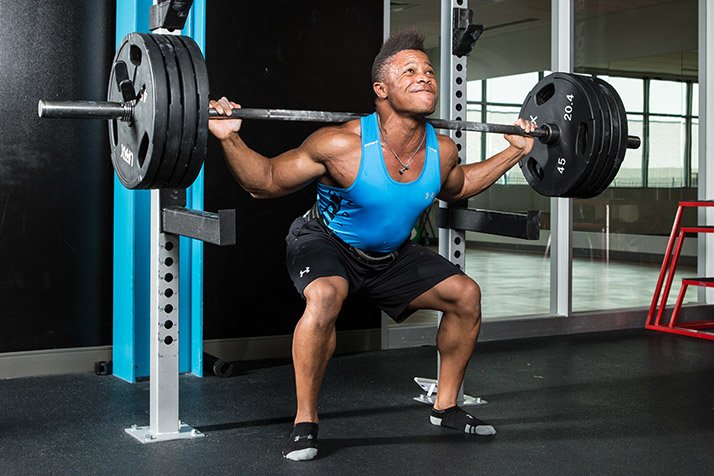
Hildebrandt points out that squatting with the appropriate volume and intensity optimizes natural muscle-building-hormone release. Higher levels of both growth hormone and testosterone have been measured following large multijoint exercises compared to exercises that recruit a smaller amount of muscle mass. There's a direct relationship between the amount of testosterone released and the amount of muscle mass engaged during a movement.1
While the debate between free weight versus machine squats has pretty much been settled in favor of free weights, don't feel limited to only high-bar squats, which is the more technical name of the bodybuilder's squat. By moving your center of gravity forward, front squats emphasize the quads over the glutes.
The powerlifter's low-bar squat places that bar further down on your back, on your rear delts—not your traps. This keeps your body in a more inclined position and slightly changes your center of mass. You'll immediately be able to use more weight with greater glute and hip action and less lower-quad activation.
Other useful free-weight variations of the basic squat include sumo, kettlebell, and even goblet.
Don't squat on a heel board or plates
Even wonder what the guy squatting with his heels on a board or small weight plates is doing? With his heels raised, his center of gravity shifts slightly forward, thus pushing his knees further forward when descending into the bottom position. That actually shifts some of the emphasis of the move to the lower quads. But it doesn't stop there. There's also more stress placed on the cartilage and tendons in the knee.
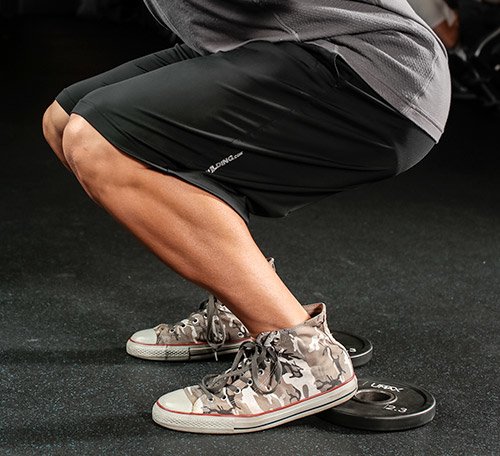
If you've got healthy knees, perhaps that's not a problem—for now. Longtime lifters almost inevitably have to deal with knee pain, so it can't hurt to start learning smarter ways to squat for knee integrity.
"The knee joint is already under stress when squatting, and when you squat on a board, you could be doing more harm than good," says Brooke Erickson, IFBB figure pro and Dymatize-sponsored athlete. "Body mechanics play a major role in joint longevity, regardless of the current health of your knees."
By far, the easiest trick to determine whether your form is on the good or bad side of knee health is to place your feet on the floor or sled, and as you descend, determine whether your knees pass an imaginary plane that comes straight up from your toes. (And yes, when you're on a hack squat, it's coming up at an angle.)
When your knees pass that plane, you're stressing the joint unfavorably. Reposition your feet—most likely higher on the platform or further away from your body when doing step-ups or lunges—so you don't pass that imaginary line. When doing lunges, you simply have to take a slightly longer step.
Change your foot position to adjust the focus of the movement
Many of us give little thought to how we position our feet during closed-chain leg exercises, putting them between hip- and shoulder-width apart and dialed slightly outward. To be sure, that's a strong base against which to push.
But many leg movements, especially machines, have large sleds from which you can use any number of foot positions. Wide or close, high or low, or even smack-dab right near the middle. Does it even matter? You bet!
Placing your feet too low on a sled increases your risk of your knees passing the plane that comes up from your toes. With your feet in that position, there's greater engagement of the muscles around the knee joint and less on the hips. This leads to more work on the quads and less on the butt.
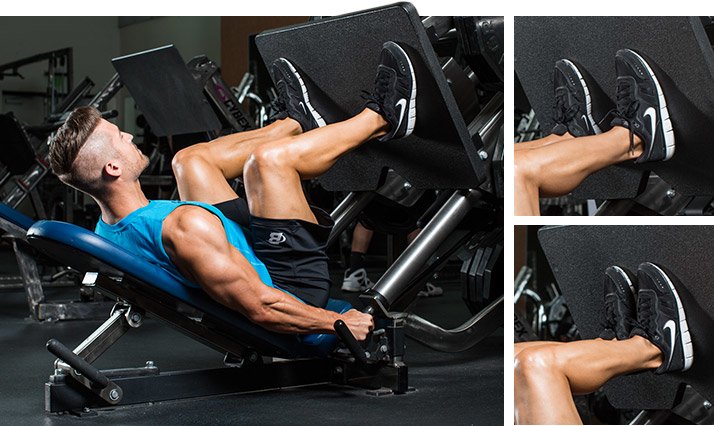
Likewise, placing your feet higher increases the degree of hip extension and flexion while reducing the range of motion around the knees. Hence, you can emphasize the glutes and upper hamstrings more effectively. Remember this shift in focus is not absolute. You simply can't isolate one muscle over another.
Wider-stance movements work the inner thighs more strongly; conversely, a closer stance better targets the outer thighs. If nothing else, you just learned a bunch of variations for leg exercises, which is especially useful with machines.
Depth of movement is critical to building your legs and butt
We've all seen the guy who loads a slew of heavy plates onto a barbell for a set of squats, only to descend a few inches. His ego may think he can handle that kind of load, but his muscle fibers are groaning their disagreement.
So-called partial reps don't target all the muscle fibers of the quads, let alone the glutes. You're simply not working the muscle completely if you're doing only half or quarter reps.
Going deeper engages the glutes and hams to a greater degree than shallow squats. Try to descend to a point at which your thighs are about parallel with the floor; your knees should be bent about 90 degrees.
"Depth of movement is absolutely critical to building your legs and butt," says Hildebrandt. "There's only one way I do squats: all the way down. Partial reps equal partial results when it comes to building some well-rounded wheels that are complete front to back and side to side. Every inch counts when you want to develop a quality physique."
Consider that the glutes and hamstrings work hard to control the rate of the descent, but really kick in when exploding out of the bottom position. Shallow squats predominantly target the quads, but not even the entire quad, depending on the actual depth.
This applies not just to squats but to all your multijoint deep-knee-bend movements. Sure, you're going to have to start with a lighter weight and do these movements through their entire range of motion to fully develop your legs. But develop them you will.
A good lower-body routine needs dedicated hamstring movements
Some individuals assume squats and other hip-extension movements are sufficient for working the hams, a group of three muscles on the rear thigh. While research shows the hamstrings are recruited during squatting motions, the recruitment is rather limited.2
"Dedicated exercises for hamstrings strength and growth are important and definitely shouldn't be lacking in your weekly leg routine," says Erickson. "Auxiliary hamstring exercises are beneficial not only for aesthetics, but for strength and speed as well as the prevention of injuries in the knees, hamstrings, and lower back."
Most of us are familiar with the family of leg-curl movements that target the hams—when seated, standing, lying, supported, or one leg at a time. They're all useful in strengthening your rear thigh.
As Erickson acknowledges, hamstrings injuries are problematic, especially when the muscle group is relatively weak (compared to the quads), which may be responsible for higher incidence of anterior cruciate ligament injuries or hamstring strains. To optimize joint stability and knee health, the quads (the antagonist muscle to the hams at the knee joint) should be stronger than the hams by about a 3:2 ratio (they're stronger because they're larger and are used more frequently during daily activities).
You can find out by measuring your strength: If you can do 10 reps on the leg extension (a single-joint movement for the quads) with 150 pounds with your 10RM, you should be able to do 100 pounds on the lying leg curl for 10 reps with your 10 RM on that movement. If you cannot complete 10 reps on the leg curl, your knee joint may be more vulnerable to injury. At the very least, you should be aware of it so you can focus your efforts on the weaker of the two.
Since women naturally have a lower hamstring-to-quad strength ratio than men—and female athletes have been shown to have even lower ratios—they're at even greater risk of hamstring strain and ACL injuries.
And for the record, here's how squatting motions work the hamstrings: By controlling the descent, as during hip flexion toward the bottom of the squat, the muscle fibers of the quads are being stretched, while those of the hamstrings are contracting. The deeper you go, the more muscle fibers of the hamstrings are recruited.
In addition, foot placement on sleds for hack squats, lying squats, machine squats, and even leg presses allow you to position your feet very high, which reduces quadriceps activation, thus enabling the hamstrings and glutes to work harder. But you'll still want to add in those dedicated hamstring moves.
Don't forget hamstring movements that bend from the hips
More than likely, you're probably familiar with the leg-curl movements mentioned above. What they all share in common is bending at the knees.
However, your hamstrings attach at both the knee and hip joints, so you can also focus on the upper-ham region by including movements in which you're bending at the hips. The best way to do so is by including Romanian deadlifts in your hamstring routine. The emphasis is not only on the upper hamstrings here, but the glutes as well, so give those glutes an extra squeeze in the standing position.
RDLs are harder to dial in your form on than you think. Keep your back flat or slightly arched throughout, and your knees should remain slightly bent. Keep the bar very close to your legs, and don't try to lower it all the way to the floor. The middle of your shin or so is perfect. RDLs are done by bending over and pushing your butt back, so the weight should never touch the floor.
A stiff-legged deadlift is not a hamstrings exercise
Don't confuse Romanian deadlifts with stiff-legged deadlift. They're very different moves.
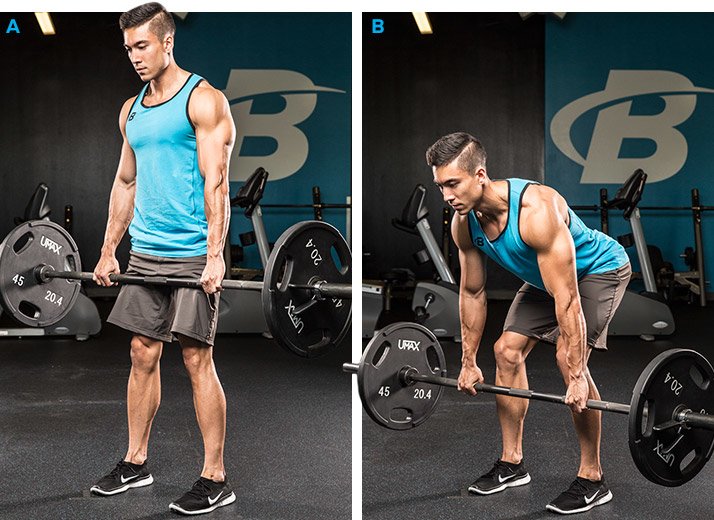
Romanian deadlift
While the SDL does recruit the hams to some degree, it's basically a lower-back exercise, not a hamstring movement, and the form is different even if their names sound somewhat close. There's no rounding of the back with RDLs because you're bending at the hips, not the waist, and the bar stays very close to your shins. Nor do you descend much past mid-thigh (depending on your flexibility).
When viewed from the side, the differences become more obvious. An improperly performed low-back exercise puts your spine discs at grave risk of damage. With RDLs, your discs are more protected because your back doesn't round.
If you do only one calf exercise, make sure it's one in which your legs are straight
Not all calf exercises work the two major calf muscles, the soleus and gastrocnemius, alike.
While most calf movements are done with straight (but not locked out) legs, bent-knee calf exercises are different. Because the gastrocnemius attaches above the knee joint, when the knee is bent, it's unable to contract very strongly, so the soleus takes on the brunt of the workload. With straight-legged movements, both muscles are called into play. Hence, doing a straight-legged calf exercise (such as standing or donkey calf raises) works the knotty gastroc, while the seated calf raise does not.
For aesthetics, most lifters want to build the gastroc, not the soleus. So if you're going to do only one calf exercise, make sure your legs are straight.
References
- Migiano, M.J., Vingren, J.L., Volek, J.S., Mareash, C.M., Fragala, M.S., Ho, J.Y., & Kraemer, W.J. (2010). Endocrine response patterns to actute unilateral and nilateral resistance exercise in men. The Journal of Strength & Conditioning Research, 24(1), 128-134.
- Ebben, W. P. (2009). Hamstring activation during lower body resistance training exercises. International Journal of Sports Physiology and Performance, 4(1), 84-96.



